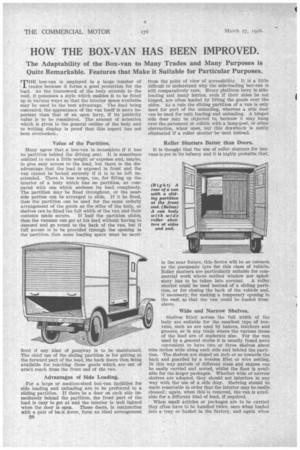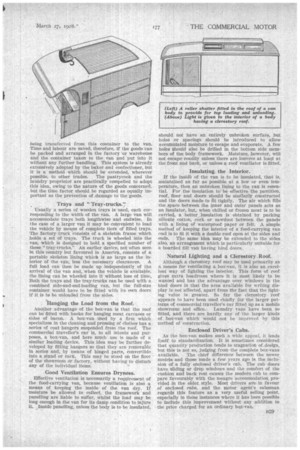HOW THE BOX-VAN HAS BEEN IMPROVED.
Page 90

Page 91

If you've noticed an error in this article please click here to report it so we can fix it.
The Adaptability of the Box-van to Many Trades and Many Purposes is Quite Remarkable. Features that Make it Suitable for Particular Purposes.
THE box-van is employed in a large number of trades because it forms a good protection for the load. As the framework of the body extends to the roof, it possesses a style which enables it •to be fitted up in various ways so that the interior space available may be used to the best advantage. The load being concealed, the appearance of the van itself is more important than that of an open lorry, if its publicity value is to be considered. The amount of attention which is given to the general outline of the body and to Writing display is proof that this aspect has not been overlooked. I
Value of the Partition.
Many agree that a box-van is incomplete if it has no partition behind the driving seat. It is sometimes omitted to save a little weight or expense and, maybe, to give easy access to the load, but there is the disadvantage that the load is exposed in front and the van cannot be locked securely if it is to be left unattended. There is less scope, too, for fitting up the interior of a body which has no partition, as compared with one which encloses its load completely. The partition may be fixed throughout, or the nearside portion can be arranged to slide. If it be fixed, then the partition can be used for the same orderly arrangement of the goods as the sides of the body, or shelves can be fitted the full width of the van and their contents made secure. If half the partition slides, then, the vanman can get at his load without having to descend and go round to the back of the van, but if full access is to be provided through the opening in the partition then some loading space must be sacri ficed if any kind of gangway is to be maintained. The chief use of the sliding partition is for getting at the forward part of the load, the back doors then being available for reaching those goods which are out of arm's reach from the front end of the van.
Advantages of Side Loading.
For a large or medium-sized box-van facilities for side loading and unloading are to be preferred to a sliding partition. If there be a door on each side immediately behind the partition, the front part of the load is easy to get at and the interior is well lighted when the door is open. These doors, in conjunction with a pair of har_:k clnrs, form an ideal arrangement 28
from the point of view of accessibility. It is a little difficult to understand why the side-loading box-van is still comparatively rare. Every platform lorry is sideloading and many lorries, even if their sides be not hinged, are often loaded by lifting the goods over the sides. As a rule the sliding partition of a van is only used for part of the unloading, whereas a side door can be used for -ooth loading and unloading. A hinged side door may be objected to, because it may hang over the pavement or collide with a lamp-post, or other obstruction, when open, but this drawback is easily eliminated if a roller shutter 'be used instead.
Roller Shutters Better than Doors.
It is thought that the use of roller shutters for boxvans is yet in its infancy and it is highly probable that, in the near future, this device will be as common as the pneumatic tyre for this Class of vehicle. Roller shutters are particularly suitable for commercial work where neither window nor upholstery has to be taken into account. A roller shutter could be used instead of a sliding partition, or for closing the back of the vehicle and, if necessary, for making a temporary opening in the roof, sp that the van could be loaded from above.
Wide and Narrow Shelves.
Shelves fitted across the full width of the body are suitable far the smallest type of boxvans, such as are used by bakers, butchers and grocers, or in any trade where the various items of the load are of moderate size. For the van used by a general stores it is usually found more convenient to have two or three shelves about nine inches wide along each side and behind the partition. The shelves are sloped an inch or so towards the back and guarded by a wooden fillet or wire netting. In this way parcels of different sizes and shapes can be easily carried and sorted, whilst the floor is available for the larger packages. Whether wide or narrow shelves are adopted, they should not interfere in any way with the use of a side door. Shelving should be made removable in order that the interior may be easily cleaned ; again, when this is removed, the van is available for a different kind of load, if required.
When small articles or packages are to be carried they often have to be handled twice, once when loaded into a tray or basket in the factory, and again when
being transferred from this container to the van. Time and labour are saved, therefore, if the goods can be packed and arranged in the factory or warehouse and the container taken to the van and put into it without any further handling. This system is already extensively adopted by the baker and confectioner, but it is a method which should be extended, wherever
possible, to other trades. The pastrycook and the laundry proprietor are practically compelled to adopt this idea, owing to the nature of the goods concerned, but the time factor should be regarded as equally important as the prevention of .damage to the goods.
Trays and "Tray-trucks."
Usually a series of wooden trays is used, each corresponding to the width of the van. A large van will accommodate trays both lengthwise and endwise. In the case of a larger van it may be convenient to load the vehicle by means of ,complete tiers of filled trays. The factory truck consists of a skeleton frame which holds a set of trays. The truck is wheeled into the van, which is designed to hold a specified number of these "tray-trucks." An earlier device, not .often seen in this country but favoured in Ainerica,•consists of a portable skeleton lining which is as large as the interior of the van, less the necessary clearances. A full load can then be made up independently of the arrival of the van and, when the vehicle is available, the lining can be wheeled into it without loss of times Both the trays and the tray-trucks can be used with a combined side-and-end-loading van, but the full-size container would have to be fitted with its awn doors if it is to be unloaded from the sides.
'Hanging the Load from the Roof.
Another advantage of the box-van is that the roof can be fitted with hooks for hanging meat carcases or sides of bacon. A box-van used by a firm which specializes in the cleaning and pressing of clothes has a series of coat hangers suspended from the roof. The commercial traveller's car is, to all intents and purposes, a box-van, and here much use is made of a similar loading device. This idea may be further developed by fitting hangers so that they are removable in series and, by means of hinged parts, convertible into a stand or rack. This may be stood on the floor of the showroom or factory, without having to disturb any of the individual items.
Good Ventilation Ensures Dryness.
Effective ventilation is necessarily a requirement of the food-carrying van, because ventilation is also a means of keeping the inside of the van dry. If moisture be allowed to collect, the framework and panelling are liable to suffer, whilst the load may be long enough in the van for its damp condition to injure it. Inside panelling, unless the body is to be insulated, should not have an entirely unbroken surface, but holes or spacings should be introduced to allow accumulated moisture to escape and evaporate. A few holes should also be drilled in the bottom side members of the body framework. Moisture, however, will not escape readily unless there are louvres at least at the front and back, or unless a roof ventilator is fitted.
Insulating the Interior.
If the inside of the van is to be insulated, that is, maintained as far as possible at a low or even temperature, then an unbroken lining to the van is essential. For the insulation to` be effective the partition, roof, floor and doors should be similarly constructed and the doors made to hit tightly. The air which fills the space between the inner and outer panels acts as an insulator, but, when chilled or frozen meat is to be carried, a better jusulation is obtained by packing silicate cotton, cork or sawdust between the panels with a lining of waterproof paper or felt. A simple method of keeping the interior of a food-carrying van cool is to fit it with a double roof open at the sides and ends. The same idea may be extended to the sides also, an arrangement which is particularly suitable for a boarded tilt van having hind doors.
Natural Lighting and a Clerestory Roof.
Although a clerestory roof may be used primarily as a means for ventilating a box-van, it is also an excellent way of lighting the interior. This form of roof gives extra headroom where it is most likely to be wanted and has the advantage over windows in the hind doors in that the area available for writing display is not affected, apart from the fact that the lighting value is greater. So far the clerestory roof appears to have been used chiefly for the larger patterns of commercial traveller's car fitted up as a mobile showroom and office. Laundry vans have been so fitted, and there are hardly any of the larger kinds of box-van which would -not be imeroved by this method of construction.
Enclosed Driver's Cabs.
As the box-van makes such a wide appeal, it lends itself to standardization. It is sometimes considered that quantity production tends to stagnation of design, but this is not so, judging from the complete box-vans available. The chief differenee between the newer models and those made a few years ago is the inclusion of a fully enclosed driver's cab. The cab doors have sliding or drop windows and the comfort of the cushion and back rest causes the modern cab to compare favourably with the meagre accommodation. provided in the older style: Most drivers are in favour of enclosed cabs, and the motor agent's salesman regards this feature as a very useful selling point, especially in those instances where it has been possible to include this improvement without any addition to the price charged for an ordinary box-van..




























































































































































































